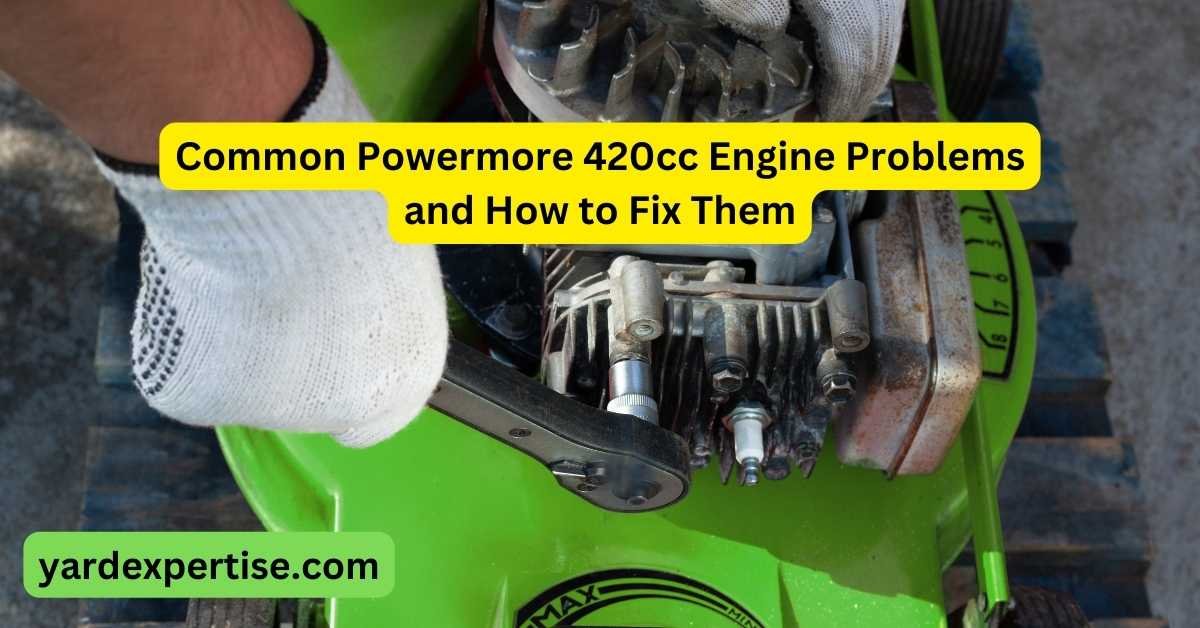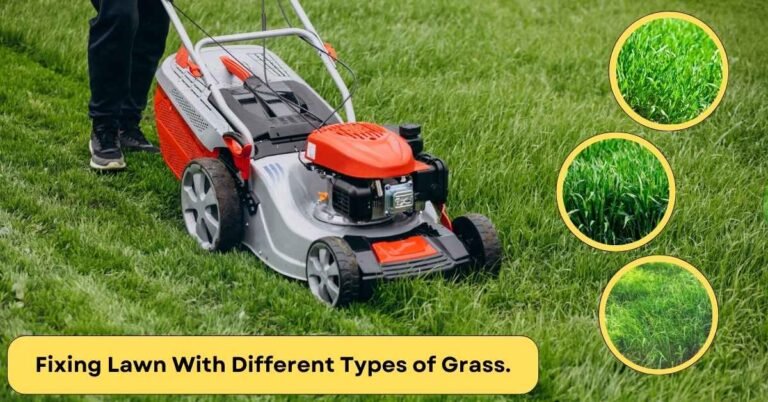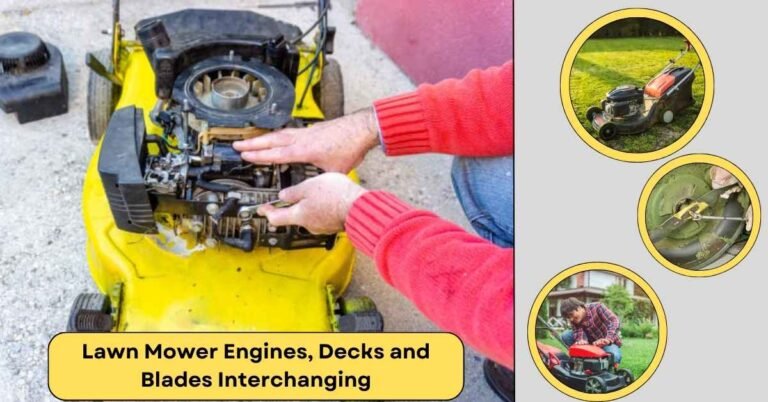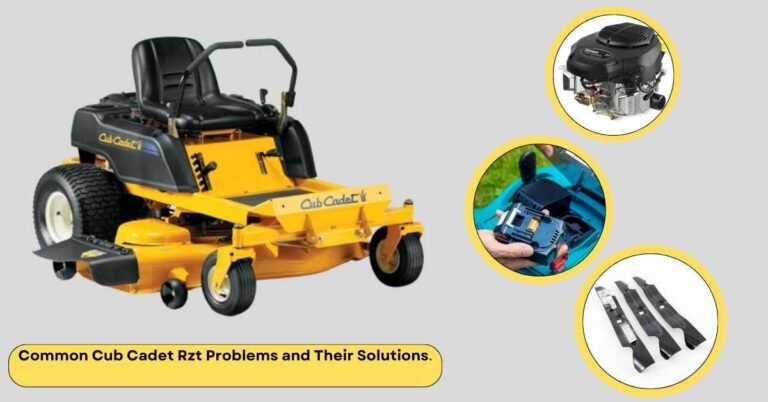9 Common Powermore 420cc Engine Problems and How to Fix Them

Powermore 420cc is a premium small block engine with an output of 12.5 HP(horsepower) and 18 ft-lbs of torque, making it a perfect choice to run machines like log splitters, pressure washers, and lawn mowers. Various models of mowers such as the Yard Machines 42″ 420cc MTD Powermore Riding Mower utilize this type of 420cc engine to perform the task of movement and trimming grass.
Even though this engine is perfect for fitting on riding mowers, log splitter, or other garden equipment, the user can run into some common problems while operating it. These include the engine not starting, the engine running rough, power loss, oil leakage and many more. With the right tools and proper guidance, anyone can fix these issues and ensure the highest output and performance from this engine.
What Are The Common Reasons and Solutions for Powermore 420cc Engine Problems?
Users might face some common issues with the Powermore 420cc Engine. They are listed below.
Powermore 420cc Engine Start Problem
There are various reasons behind the engine failing to start. The most common causes of this problem and the solutions are listed below.
- The engine is flooded: This means that the engine contains an excessively rich mixture of air and fuel in its chambers and cannot be ignited.
Solution: Wait at least 10 minutes before you start the engine. The fuel and air mixture will get diluted.
- Spark plug wire disconnected: The Spark plug is not taking power from the battery or the engine.
Solution: Connect the wires to the plug. Check the wire with a multimeter to see if it is functional. Change the wire if it is beyond repair.
- Fuel Tank empty or stale fuel: There is not enough fuel to start the engine or the fuel that is inside the tank is too old and stale.
Solution: Empty the tank completely and then use fresh and clean fuel to fill the tank.
- Engine not choked: Choke modifies the air pressure in the intake manifold to supply a richer mixture of air and fuel to start the engine. Not choking the engine properly can cause it to not start.
Solution: Use the choke of the engine properly.
- Faulty spark plug: A faulty spark plug does not provide the necessary flicker to start the combustion process in the engine.
Solution: Clean the carbon or dust build-up on the spark plug. Adjust the gap if it becomes too widened. Replace the part entirely if necessary.
- Throttle in stop position: The engine will not be supplied with any fuel if the throttle is in stop position.
Solution: Move the throttle to the FAST/RUN position.
Engine Stalling or Running Rough
The engine might run erratically making noises and unwanted motions. The common reasons why that might happen are given below.
- Spark plug wire loose: Loose wires connecting the spark plug with the battery and the engine might cause the plug to ignite improperly and cause the machine to run erratically.
Solution: Connect and tighten the wire connected to the spark plug.
- Faulty spark plug: The engine will be running rough if the spark plug gets scorched, defective, or the electrode gap is set incorrectly.
Solution: Clean, adjust, and if needed, replace the spark plug.
- Stale fuel: Old and unclean fuel might also cause the engine to run rough.
Solution: Fill the tank with fresh and clean gasoline.
- Engine running with choke on: A choke is important to start the engine but it will cause the engine to act irregularly if it is kept turned on during operation.
Solution: Turn off the choke.
- Water or dirt in the fuel system: Dirt or water build-up in the fuel tank might be the culprit behind the engine running rough.
Solution: Drain the entire fuel tank. Clean it properly. Then fill it with fresh and clean gasoline.
Overheating Issues
Overheating issues stem from the engine oil level being too low. Without sufficient engine oil, the engine struggles to run properly. Regularly check the oil level of your engine. Fill the engine with the correct amount of engine oil to avoid this issue.
Smoke or Exhaust Issues
Carbon or dust buildup in the exhaust pipe can cause issues while running the engine. The problem is in the fuel if you notice the engine exhausting too much black smoke. Keep the exhaust pipe clean from all the dust, debris, and carbon build-ups to avoid this problem. Use clean and fresh fuel and quality engine oil to solve smoke issues.
Power Loss
Erratic performance of the engine can result in less power output than expected from the engine. Troubleshooting and solving the engine issues will solve this problem of power loss.
Oil Leaks
Damage to the fuel tank or the gaskets can cause oil leakage from the engine. Make it the utmost priority to fix any damage to the fuel tank.
Spark Plug Issues
The spark plug can have carbon or dust build up on its electrodes, get corroded, or the gap between the electrodes can be set improperly. Clean, adjust, and replace with spare parts if required.
Fuel System Problems
Fuel system problems can stem from bad or clogged fuel injectors, clogged fuel filters, clogged or leaking fuel lines, or malfunctioning fuel pumps. Keep these components clean from dust and carbon build-up and replace them if necessary.
Poor Performance and Power Output
Poor performance and power output are directly related to the condition of the engine. The performance and power output will not be up to the liking if the engine runs erratically. Fix all the engine issues to ensure proper performance and power output.
What Are the Precaution Tips to Avoid Powermore 420cc Engine Problems?
Regular inspections and adjustments are absolutely vital to ensure that your machine provides a high level of performance and lasts for a long time. Regular maintenance works and proper storage will keep the mower in pristine condition and you will be able to avoid all the engine problems altogether.
Regular Maintenance Tasks
Components of the engines are subject to getting dirty because of dirt, debris, and carbon build-up and they also wear down over time. Regular inspections of these parts are key to ensuring the proper function and longevity of the machine.
Oil changes
Engine oil ensures proper lubrication for all the moving parts and keeps your engine running smoothly. Change the engine oil after the first 5 operating hours. Check engine oil level before and after using and after every 5 hours of usage. Change engine oil every season or after every 50 hours of usage.
Air filter cleaning/replacement
Air filters are prone to getting dirty as dust and carbon build up inside them. Check and clean your air filter before and after using and after every 5 hours of usage. Service or replace the air filter after every season or after 100 hours of usage.
Spark plug maintenance
Spark plugs are vital to the function of the engine as they create the necessary ignition in the engine. Check your spark plug for carbon build-up, corrosion, and improper gaps after every 25 hours of usage. Replace the spark after every 100 hours of usage.
Proper Storage
Storing for a long period or shorter periods requires special considerations of several factors like draining the fuel tank, using fuel stabilizers, storing in proper conditions and so on.
Winterization
You must follow some procedures while storing the engine for off season like in the winter. Empty the gas tank either by draining all the fuel manually or by running the engine until all the fuel is used. Then pour a few ounces of high-test gasoline and a little fuel stabilizer. Start and run the engine for 10-12 minutes or so to make sure the fuels reach all the components of the engine. Let the engine cool off by waiting 20 minutes. Then run the engine until all the fuel is used. Twist and open the drain plug to get the excess oil out of the carburettor.
Long-term storage tips
Completely drain all the fuel from the machine if you wish to store it for more than 90 days and use a gasoline stabilizer if you wish to store the engine for fewer than 90 days. Change the oil according to the instruction manual. Then remove the spark plug and pour in approximately ½ ounce of engine oil into the cylinder. Replace the plug and crank the machine slowly to distribute the engine oil to all the components. Cover the areas that are prone to rusting with oil.
Store the engine in a clean, dry, and well-ventilated area and keep it away from any appliance that operates with heat or flame like a water heater or a furnace. Keep the engine in a place where there is low humidity to avoid rusting.
Keep the engine leveled on the surface as tilting can cause fuel or oil leakage
Fuel System Cleaning & Care
Fuel systems get dirty over time with dirt, varnish, and carbon build-ups and require routine maintenance. Regularly clean all the debris from the fuel system, air intake, valves, injectors, and combustion chambers. Service or replace the fuel system if it gets beyond repair.
Fuel quality considerations
Always use high-quality oil that the manufacturer specifies in the instruction manual for the engine. Use sufficient engine oil as required and periodically change engine oil. Do not use two-stroke cylinder oil in four-stroke engines. Use fuel stabilizing additives while storing the engine for short and long periods of time to avoid damage to the carburettor.
So, troubleshoot all the problems and fix them to ensure that your Powermore 420cc Engine performs without any issues and outputs the desired level of power, making all of the activities with the engine smooth and comfortable.





